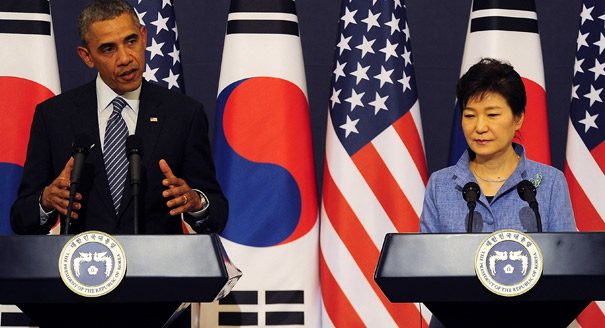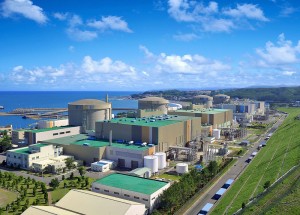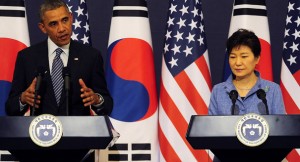This blog post features reflections from Dr. Robert Borrelli, an Adjunct Professor at Diablo Valley College. Dr. Borrelli received his PhD in Nuclear Engineering from UC Berkeley in 2006, and he maintains active interest in the impact of nuclear technology on society. This work does not reflect the opinions of the NPWG or any government entity or agency.
I recently read a very good article by Duyeon Kim summarizing the political issues surrounding the renewal of the 123 Agreement between the USA and South Korea (ROK). This is a very important issue to me because my research field is in safeguards, safety, and security (3S), and safeguards by design (SBD). This is also known as “safeguardability.” The 3S concept essentially proposes that the institution of safeguards measures for any particular nuclear facility should be given equal weight to those of safety and security and that this can be achieved through SBD; i.e., building a facility to include safeguards concepts as part of the design strategy. Historically, this has not been the case. Safeguards measures were instituted after facilities had been constructed. As a result, costly retrofits have to be undertaken upon International Atomic Energy Agency inspections.
Why it matters. The 123 Agreement should be of importance to anyone in the nuclear energy field because it underscores that technical and engineering problems are inherently social problems as well. Effectively implementing a 3S concept for the nuclear fuel cycle requires a holistic effort that will involve collaboration between engineers and policy and social science experts.
Additionally, I attended a symposium on the UC-Berkeley campus about this very issue on September 19, 2014. Based on my interactions with the people who attended the symposium, and the recent article on the 123 Agreement, I wanted to offer my point of view on this important issue. The article is very good explaining the politics of the USA-ROK 123 Agreement. My intent is to discuss some technical challenges within this context. This piece is intended as a technical supplement to the article.
The 123 Agreement. 123 Agreements for Peaceful Cooperation originate from the US Atomic Energy Act and “requires the conclusion of a specific agreement for significant transfers of nuclear material, equipment, or components from the United States to another nation.” The United States has several of these agreements with other nations, including Japan. The intent of these agreements is to strengthen the global nuclear nonproliferation regime. The USA and ROK initially signed an agreement in 1974. It was set to expire in March 2014. Both nations agreed to extend the agreement as is until 2016.
Technical problems. A little less than one-third of the electricity in ROK is produced by nuclear power, approximately 20 GWe. Currently, used fuel from the reactors are stored onsite in pools. However, it is expected that the storage space will reach a saturation point around 2020. The ROK government wants to increase the share of nuclear power to the national energy grid because 97% of energy resources are imported. Therefore, the storage space will become an even greater problem.
Technical solutions. Clearly, the most straightforward solution would be for ROK to build a repository for the used fuel, just like Finland is doing, or as the USA has tried to do with Yucca Mountain. A repository has been internationally recognized as a solution to long-term nuclear waste storage. Building a repository is no easy task, however, and it engages a host of unique social issues. The entire process can also take several decades.
The use of a repository to solve the storage problem leads to a very interesting question: Is used fuel a waste or a resource? Used fuel can be, and is, recycled into a mixed-oxide product containing plutonium and uranium. France is the most notable example, but five other nations also “reprocess” nuclear fuel. “Reprocessing” is placed in quotes here because the 123 Agreement prohibits ROK from reprocessing nuclear fuel. I come down on the side of resource primarily because the amount of nuclear waste is significantly reduced if used fuel is recycled. This is the most technical point of contention in the 123 Agreement renewal.
Pyroprocessing. ROK proposes to recycle used fuel by pyroprocessing and beginning to level up to a closed, Generation IV advanced fuel cycle. ROK additionally claims that “pyroprocessing” is not “reprocessing.” Pyroprocessing treats used ceramic oxide fuel by electrochemical means to produce a metal fuel product consisting of uranium and transuranic elements for use in a Generation IV reactor. Kim makes a slight error in the article by calling pyroprocessing a “new technology.” Pyroprocessing itself is used for a host of industrial applications and has been for decades. Pyroprocessing for nuclear-related activities is not that new either. The technology was proven on the engineering scale in the 1950s with the EBR-I project. This lead to EBR-II and the IFR projects in the 1980s and 1990s. It is true that the implementation of this technology has not been proven on the commercial scale, and it is widely acknowledged that scaling up presents many difficulties.[1]
Semantics. I find it interesting that there is contention around the use of pyroprocessing and reprocessing in such high-level negotiations. Semantics are important as to how one communicates a highly technical problem. In this piece, I refer to “used fuel.” In the article, Kim uses “spent fuel,” as do many others. Spent fuel carries the connotation that additional usage of the material has been exhausted. Therefore, it is easy to understand how this could be considered as waste. I refer to used fuel because this implies that it can be reused, and therefore, it is considered a resource.
Although, I suppose one could argue that “used” could also mean “used up” and still refer to waste. I would argue that one could just as easily say “used some more,” and so on. The semantic waltz around these terms may seem frivolous and trivial, but this is technical issue is actually very important technical to the success of the 123 Agreement.
Reprocessing vs pyroprecessing. What’s in a name? What is the difference between “pyroprocessing” and “reprocessing” then? Fundamentally, these both refer to the recycle of used fuel for reuse in a reactor. The concepts behind these terms are how each nation frames their perspective on proliferation. From what I have studied on this issue, “reprocessing” = “PUREX.” This is the contemporary technology employed to recycle used fuel.
PUREX, however, will produce a pure stream of plutonium. Pyroprocessing does not. Plutonium is never chemically separated from the rest of the transuranic elements. This is a fundamental technical issue between the two nations and it has far reaching implications.
The problem in renewing the 123 Agreement is about how each nation wants to address proliferation. I should point out that no technology is completely proliferation resistant. This is not debatable. A nation that has the technical capacity to implement pyroprocessing also has the capability to conceivably divert the pyroprocessing product and make a nuclear weapon. What is debatable is the extent of proliferation resistance that pyroprocessing offers. ROK proposes it is adequate, while the USA disagrees.
Beyond the technical. Kim astutely points out that “South Korea imports almost all of its energy, at a cost that is reportedly greater than what the country earns in producing automobiles, semiconductors, and ship exports—its main growth drivers.” While the problem of used fuel storage is definitely real, nuclear power is also framed in terms of economics and growth. It is not mentioned in the article, but the ROK wants to export its nuclear power technology to other nations. The gist of Kim’s piece is that the ROK perspective includes proliferation as one of many national concerns, and I agree with that analysis. It seems as though the USA considers it to be the concern. This supports one of the criticisms addressed at the symposium: the ROK is not treated on equal footing with the USA, and that unequal footing complicates negotiations considerably.[2]
Nuclear weapons. Neither party is wrong, per se. There are many credible reasons for the USA to be concerned about unintended consequences if the ROK wants to implement pyroprocessing. The “nuclearization of the Korean peninsula” is not mentioned in the article, but it looms large around the renewal of the 123 Agreement. North Korea possesses nuclear weapons. It is unlikely that North Korea would invade the ROK to acquire pyroprocessing materials, but I can understand the position of “let’s not add fuel to the fire.” No one can really predict the North Korean reaction if the ROK were to pyroprocess. Is it fair? Probably not. The entire global nuclear weapons regime is not really fair, though I agree it is still necessary. It would be irresponsible for a nuclear state to allow a non-nuclear weapons state to step closer to the acquisition of nuclear weapons.
However, only a short distance away, Japan has built a reprocessing facility for PUREX.[3] Additionally, the USA does have a 123 Agreement with India. This is a nation that openly possesses nuclear weapons and has not signed the Nonproliferation Treaty. Furthermore, Iran, a nation that has violated its international nuclear agreements, is still allowed to enrich uranium. Kim explains each position quite well in the article.
What stands out to me as the most egregious double standard is the case of Japan. I do not have a problem with Japan reprocessing used fuel. They have signed all the international agreements and submitted to all of the subsequent inspections. The ROK seems willing to do the same. I just do not quite understand the USA position here. Qualitatively, PUREX is more of a proliferation risk. The ROK claim of unequal treatment does have some merit.
New solutions. Experts offered many different technical solutions at the UC Berkeley symposium in order to reconcile the 123 Agreement for both nations. One I particularly support would be the establishment of an interim storage facility. This was discussed by Dr. Yonsoo Hwang.[4] While I could discuss this at length, in short, an interim facility avoids the issue of ROK currently opting for pyroprocessing, while also addressing the dwindling onsite capacity. This could also potentially enhance safety and security as well. However, there are many other technical and social factors to address; namely, any siting process would still require consent of the locality.
There needs to be better ways to quantify proliferation. I do not suggest that the 123 Agreement can be resolved through strictly technical means, but I do suggest that a new technical approach could be useful. Currently, America and South Korea seem stuck getting past the “pyroprocessing’” and “reprocessing” debate. Proliferation is only discussed on qualitative terms.
I suggest that safeguardability methodologies are needed. Different facilities for all stages of the fuel cycle could be quantified, for example, by a conventional risk-informed approach. This ties into Dr. Chaim Braun’s discussion.[5] At the symposium, he proposed that ongoing criteria be established for new facilities that would be needed if ROK levels up to pyroprocessing in order to implement an advanced fuel cycle. I interpreted this as similar to a performance-based concept. Therefore, safeguardability methodologies could be used to quantify these criteria. The transition to the advanced fuel cycle would then be more structured. This is of course a long term approach, but incorporating the interim storage facility could readily fit into this performance-based approach. There is currently a lack of consensus on what exactly would be quantified; on the other hand, this leaves considerable latitude for study.
While this kind of technical work is very interesting, it requires legal backing both in the form of existing international treaties and domestic regulatory infrastructures. If a nation “buys in,” and is willing to implement a fuel cycle in which it is exceedingly difficult to divert nuclear material for weapons fabrication, this may build more trust between negotiating parties.
Implications. The negotiations between the ROK and the USA over renewal of the 123 Agreement underscore how engineering problems are also social problems. Implementation of any nuclear fuel cycle needs to be considered holistically, with technical experts interfacing with their counterparts in many global policy arenas. Kim’s piece offers a compelling discussion of all of the policy-relevant matters, and I have endeavored to offer a technical viewpoint to supplement the policy discussion.
This 123 Agreement may serve as a test case for other nations. While nuclear energy development is stalled in the USA, it is not in Asia. Japan is restarting some of their reactors soon, the ROK obviously has a clear interest in expanding their nuclear energy grid, and there are emerging countries, such as Vietnam, who want to start nuclear energy programs. The resolution to the USA-ROK nuclear energy issue could set an influential precedent for other nations while also strengthening the global nonproliferation regime and simultaneously promoting needed economic growth in the region.
[1] My field of research currently is focused on safeguardability of pyroprocessing. My last postdoctoral position at UC Berkeley was funded by the Korean Atomic Energy Research Institute. [2] Ro-byug Park, Ambassador for Nuclear Energy Cooperation and Special Representative for ROK-US Nuclear Cooperation, Ministry of Foreign Affairs, Republic of Korea. [3] It is not operational yet. [4] Director General, Korea Institute of Nuclear Nonproliferation and Control. I also worked with Dr. Hwang at UC Berkeley during my last postdoctoral position. [5] Consulting professor, Center for International Security and Cooperation, Stanford University.





